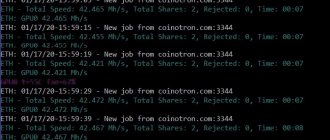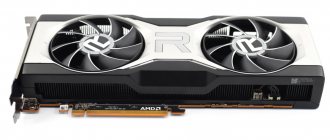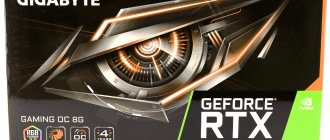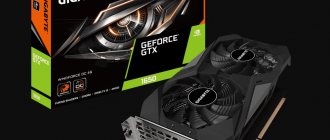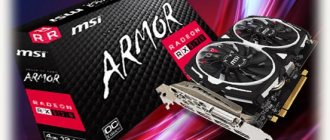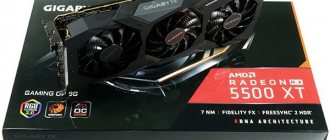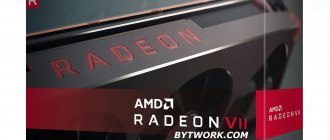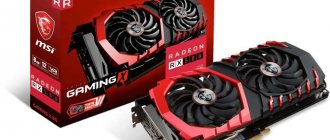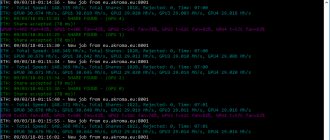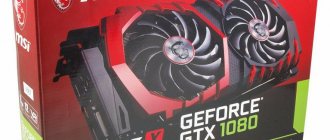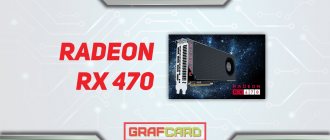In this review, we will look at the 8 GB version of the MSI Radeon RX 5500 XT GamingX 8 GB video card from AMD.
The card is equipped with 1x8 Pin connectors and consumes from 100 Watt to 140 Watt depending on overclocking, miner and algorithm.
Specifications
| Specifications | MSI Radeon RX 5500 XT |
| Video memory | GDDR6 8GB |
| CPU frequency | Boost frequency: 1845 MHz |
| Energy consumption | From 100 Watt to 140 Watt |
| Power connectors | 1×8 Pin |
| Noise | ~0 ~ 34 dB |
| Dimensions (cm) | 215 x 128 x 40 mm |
| Weight (g) | 705 |
| Official site | MSI |
Temperatures and internal structure
The 5500 XT is available in both 4GB and 8GB models (the only difference is VRAM capacity).
We remind you that the MSI Radeon RX 5500 XT model is available in an 8 GB version.
Secondly, AMD told us about the pricing: the 4GB model will sell for ~$190, while the 8GB model will cost $35 more.
The MSI Radeon RX 5500 XT 8 GB video card will be sold at a price of ~$225 in the CIS, which is only $25 more expensive than the Sapphire RX 5500 XT Pulse 4 GB
This means that the 4 GB model is sold at almost the same price as the Nvidia 1650 SUPER in the ~$170 market segment, the situation with the 8 GB card is slightly different, it is more expensive than the 1650 SUPER, but cheaper than the 1660 SUPER. In fact, with GTX 1660 prices dropping since the introduction of the 1660 SUPER, 1660 cards are now available for as little as ~$200.
The last thing to note in this review is how the RX 5500 XT fits in with the rest of the RX 5500 series. When AMD made the initial announcement back in October, the core specification for the RX 5500 series was announced, but the 5500 XT is straight was not mentioned.
As it turns out, both the RX 5500 and RX 5500 XT use the same GPU with the same number of cores. The main differences are that the RX 5500 (not the XT) has slightly lower clock speeds, is only available in the 4GB variant, and is only available to OEMs.
The RX 5500 XT is available as a standalone card, so unless you want to buy an off-the-shelf (laptop) build, you'll have to forget about the non-XT version of the 5500.
Test results
To evaluate the performance, I took a stand with a Core i9-9900K processor @ 4.9 GHz, 16 gigabytes of DDR4-2400, and a 240 gigabyte M.2 NVMe SSD drive. As tests, we used different games from the last three years.
It is worth adding a small explanation regarding the graphics settings and symbols on the diagrams. The designations “High Detail”, “Med Detail” and “Low Detail” correspond to the maximum, medium and minimum graphics settings in games, respectively. If there are more than three settings options (as, for example, in Assassin's Creed Odyssey), then “Med Detail” corresponds to the “High” preset, as the average among all possible ones (“Maximum High”, “Very High”, “High”, “Medium” , "Low"). If there are an even number of options (four, for example), then “Med Detail” corresponds to the “medium settings” or “Medium” item in the game menu.
For Honor can confidently run at 1080p and 1440p - the game is light, there are no problems with refreshing. 4K, despite the substantial amount of video memory, the 5500XT is not capable of, except that at minimum quality settings you can achieve smoothness and get rid of periodic jerks.
Heavy and clumsy Tom Clancy's Ghost Recon Wildlands manages to drop the average FPS below 50 even at 1080p, so you have to sacrifice quality for the sake of refresh. At medium and low settings, you can comfortably play at 1440p, but it’s better to forget about 4K. All other things being equal, it is better to lose twice the resolution and run in 1080p on medium settings than in 4K on minimum (with a physical matrix resolution of 3840x2160).
In Far Cry New Dawn, the indicators change little when changing quality settings, and in general the game is very stable in the refresh created. 50–60 FPS at 1080p and 1440p is enough for a comfortable game with maximum quality settings. If you wish, you can run it in 4K on medium presets, but 30–40 FPS is frankly not enough, and rare loading times begin to irritate.
Control is a tough task for the 5500 XT, and only 1080p can be considered fully “suitable” for comfortable gaming. In 1440p, refreshing is acceptable only on minimal detail, but in 4K with its 15–27 FPS there is absolutely nothing to do, constant stutters and slideshows.
Assassin's Creed Odyssey puts a lot of stress on the 5500 XT at maximum quality settings in all resolutions, so you'll have to choose between medium and minimum settings at 1080p or 1440p. However, if you are not too picky about freezes and slowdowns, you can run it at maximum and at 1920x1080, but there will be no pleasure.
Metro Exodus, surprisingly, pulls out almost 40 FPS on the Extreme profile. But it’s better to choose low detail in 1440p or medium and low detail in 1080p; the gameplay is much smoother and more enjoyable, especially in well-lit “natural” locations.
The abundance of small details in Total War: Three Kingdoms significantly drains the refresh at maximum detail; FPS is almost two times less than at medium settings at the same resolution. The 5500 XT confidently “digests” 1080p and 1440p, excluding, perhaps, only high detail at 2560x1440.
The situation is similar in Tom Clancy's The Division 2: maximum settings cut the performance by half. Overall, for dynamic games (and especially raids), you should choose either 1080p or 1440p at medium settings. Or, as an option, fine-tune an intermediate value when both the graphics are normal and the FPS is acceptable.
The main advantage of the STRIX version relative to the “native” references is the low noise level. With automatic adjustment, the speed under load does not exceed 1400 per minute, the video card is barely audible from a meter away on an open bench. True, the temperature of the GPU sometimes rises to 75 degrees. By modern standards, this is not much, but I would like to see smaller numbers.
If you manually “tweak” the speed to 60% of the maximum (about 2100 per minute), then to completely get rid of the noise you will have to move the system into the case, but the temperatures are worth it - 67 Celsius under load.
80% of the maximum (2500 rpm) - and another minus four degrees.
At full power, at 3100 rpm, the fans rustle noticeably, and the sound penetrates a considerable distance through the closed case. The maximum reading under load is 62 degrees. A good indicator, but not the best.
The already familiar GPU Tweak II acts as proprietary software. The range of features is extensive and is designed for both the novice user and the enthusiast who wants to get the most out of his copy. There are three basic profiles with slightly different settings: Sinent Mode, OC mode and Gaming Mode.
Monitoring is a useful thing for fine tuning. ASUS has transferred the graphics style from RivaTuner (now MSI Afterburner) to their application. It turned out organic and practical.
On a separate tab, you can manually set frequencies, GPU voltage, and Power Target. For the fan, it is possible to plot your own graph of the speed depending on the GPU temperature.
GPU-Z is also built-in to obtain all technical information about the video card. You can also download FurMark to stress test your video card after setting the desired frequencies and voltages.
Such wide functionality, coupled with the familiar and original corporate style, makes GPU Tweak II a practically useful tool, unlike many “half-measures” released for show.
The Aura application provides ample opportunities for customizing the RGB lighting of the logo: color “pattern”, intensity, dependence of the glow on external parameters. It looks nice, it’s not an eyesore, and you can turn it off completely if you want.
Equipment
The MSI Radeon RX 5500 XT comes in a dark box with an image of the card itself on the front, "MSI" with the logo, and "Gaming X" written on it.
On the back of the box we see the technical specifications and description of the cooler (cooling system).
The package consists of:
- Box
- Video card
- User guide
- Stand
The equipment is standard for MSI and, in general, for such a budget video card.
Which RX 5000 series video card should you choose?
The first pair of video cards in the series is suitable for novice designers and gamers. They have an excellent price/quality ratio, so PCs with them are not expensive. The second pair of video cards in the series is suitable for experienced professionals and gamers. They demonstrate good results in modern video games even at maximum graphics settings. The third pair of video cards is suitable for those who love high quality graphics and smooth gameplay. This video card is not very suitable for e-sportsmen, but for connoisseurs of high-quality images it is ideal.
Cooling system
GPU specifications for the RX 5500 XT have been online for two months, so nothing new has been revealed to us. Built on the same Navi architecture as the RX 5700 and RX 5700 XT and based on TSMC's 7nm process, the RX 5500 XT features 22 processing units (CUs) and 1,408 stream processors.
The same 14 Gbps GDDR6 memory has also been scaled down compared to the RX 5700 series for 4GB or 8GB models. However, the 5500 XT has a narrower 128-bit memory interface, which means total memory bandwidth is 224 GB/s, or half that of its more expensive siblings.
In terms of clock speeds, the MSI card meets the reference specification with a clock speed of 1845 MHz (as do all the other cards we've reviewed). Total power consumption is rated at 140W, which is 40W higher than the GTX 1650 SUPER.
Let's move on to analyzing the video card itself. MSI uses the same styling for its RX 5500 XT Gaming X card as it does on other Navi-based Gaming X cards. The map is dominated by black and gray colors, with some red accents.
As for the casing, it is made of good plastic, not the most durable, but we are ready to give the case 4 out of 5.
Let's move on to the external cooling system - coolers. MSI uses two 90mm fans, which in total do not cover the entire graphics card area, approximately 70%.
On the top side of the card is the MSI inscription with their dragon logo. This is the only RGB spot on the entire map.
Dimensions of the video card are 215 x 128 x 40 mm . This is a large dual-slot card.
Let's move on to the back side of the video card - the backplate, this model has one. The back panel is made of metal and protects the card from damage during installation and use.
Please note that there are a couple of cutouts on the backplate (most of them in the GPU area) that additionally filter hot air.
Having disconnected the backplate, we see that thermal pads are attached to it, which additionally cool the memory and VRM on the back side of the printed circuit board.
Let us remind you that the backplate itself will not help dissipate heat from the back of the board, but will provide additional rigidity to the structure and help protect the card from mechanical damage.
Internal cooling system
Let's move on to analyzing the video card itself. Let's start, as usual, with the radiator grille.
The radiator grille consists of 2 stacks, which are connected by a plate with a copper middle, which is in contact with the GPU.
Four heat pipes run through the grille to cool the card.
Please note that thermal pads are attached to the grille for additional cooling of the memory and VRM.
Having disconnected the radiator grille, we see that 1 more plate is attached to the printed circuit board, to increase rigidity, it does not cool the card in any way.
Removing the plate reveals the bare PCB, it looks good.
MSI chose a 6-phase VRM for the GPU, controlled by the International Rectifier IR35217 controller.
As for memory, we see 4 dual dies, each 2 GB, from Micron. The memory is labeled " 9 TB47 D9 WZX ". They are designed to operate at 1750 MHz (effective GDDR6 14 Gbps).
The AMD Navi 14 GPU is their second chip to use the new RDNA graphics architecture. It is manufactured using 7-nanometer technology and has a transistor count of 6.4 billion. The matrix size is only 158 mm².
On the reverse side of the printed circuit board, as we have already said, thermal pads are attached. The printed circuit board without the backplate looks like this:
Thermal photographs
All thermal images were taken under maximum load for a general overview and understanding of the cooling system with a slight overclocking of the core and memory.
Having installed the thermal camera on top, we see that the GPU temperature does not exceed 45 degrees. This is an excellent indicator.
The memory temperature remains at 37 degrees.
However, it is worth understanding that the card’s maximum consumption is only 140 Watts, which is in fact very little by modern standards.
Please note that the coolers do their job perfectly, the residual heat is dissipated and is not stored inside the card.
Having installed the camera from the back of the video card, where the backplate is located, we see that the GPU temperature does not exceed 64 degrees . This is a good result, but for a card with such consumption and a cooling system, we expected GPU temperatures to be much lower.
In progress
ASUS ROG-STRIX-RX5500XT-O8G-GAMING supports 0dB Fan technology, stopping fans in idle mode.
At minimal load, the temperature of the chip and memory chips is kept at 40C.
After gaming tests, the GPU warmed up to 62 degrees, with the temperature of the maximum heating point being 78C. GDDR6 chips heated up to 76 degrees.
The registered peak frequency is even slightly higher than the specified Boost Clock - 1865 MHz. A fairly efficient cooling system allows the GPU to maintain operating frequencies at a high level. It often fluctuates between 1800–1850 MHz.
The maximum fan rotation speed is about 1750 rpm. However, such values admittedly came as a surprise, because the actual turnover in games is often noticeably lower. 1100—1500 rpm. Occasionally, the rotation speed increases, and, it would seem, there are no special reasons for this. However, such fluctuations slightly spoil the overall statistics. In any case, there are no problems with increased noise levels. In addition, lovers of silence can use the additional Quiet Mode by switching the toggle switch on the top edge of the video card.
In this case, the base frequency has dropped to 1647 MHz, but the peak frequency (Boost Clock) remains the same - 1845 MHz.
After changing the mode, the GPU temperature under load increased to 65C, the memory temperature to 80C. At the same time, the fan rotation speed did not exceed 1400 rpm, and the average operating speed also decreased. At the same time, the transition to Quiet Mode did not actually affect performance, because the peak GPU frequencies remained at the same level.
Hashrate
Using the Ethash algorithm in stock, this card produces 25.1 Mh / s .
With Power Limit “-50” and a slight overclocking of Memory Clock “930 NHz”, we get 26.3 Mh / s .
How much can you earn
The MSI Radeon RX 5500 XT GamingX video card mines best with the Ethash algorithm, followed by the Cuckaroom29 and Cuckatoo31 algorithms.
Knowing that this video card works well on the Ethash algorithm (Ether Coin) and knowing its hashrate, you can calculate the payback of this video card, how much it will bring per day, month, year.
.
To calculate, enter the hashrate of this video card in the “Hashing Power” column, in our case it is 25.1 Mh/s
in stock or
27Mh/s
in overclocking
“ Pool Fees ” is the pool commission, you don’t have to enter it if you don’t know. The average commission for all pools is 1%.
Next, in the “ Power Usage ” column, you need to enter the power consumption of the video card (farm). In our case it is 130 . We enter this number in this column.
“ Power Cost ” is the price for your electricity (“per socket”). Enter the value in cents. For example, our electricity costs an average of 3 rubles – that’s $0.05. Enter this or another number of yours.
That's all! Click on the “ Calculate ” button and find out how much you will receive from 1 video card per day, week, month, year!
Memory and power consumption
The video card is equipped with 8 gigabytes of GDDR6. Most often available from Micron .
As we have already said, the memory is marked “ 9 TB47 D9 WZX ”.
Card consumption is from 100 to 140 Watts, depending on the miner and overclocking.
The card is equipped with 1x8 Pin power connectors, which is very convenient in terms of purchasing a unit for an entire farm, since only 1 wire is used per card.
For a farm of 6 MSI Radeon RX 5500 XT 8 GB video cards and a connected power system (motherboard, SSD, processor), you will need 1 1100 Watt power supply or 2 600-700 Watt units.
You can find out how to power the farm with 2 power supplies on our website.
Also on our website you can choose an excellent block for mining: in the corresponding section there are detailed articles about different power supplies: their configuration, efficiency, drawdowns, ripple, analysis and much more.
Test bench configuration
| CPU | Intel Core i7-8700K (6/12; 3.7/4.7 GHz) | Intel, www.intel.com |
| Motherboard | ASUS ROG MAXIMUS X Hero (Intel Z370) | ASUS, www.asus.ua |
| RAM | HyperX Predator RGB DDR4-3600 16 GB (HX436C17PB3AK2/16) | HyperX, www.hyperxgaming.com |
| Storage device | Kingston KC2000 1 TB (SKC2000M8/1000G) Kingston A1000 480 GB (SA1000M8/480G) | HyperX, www.hyperxgaming.com |
| power unit | Thermaltake Toughpower Grand TPG-1200M (1200 W) | Thermaltake, www.thermaltakeusa.com |
| Monitor | Acer Predator XB271HK (27″, 3840×2160) | Acer, www.acer.ua |

